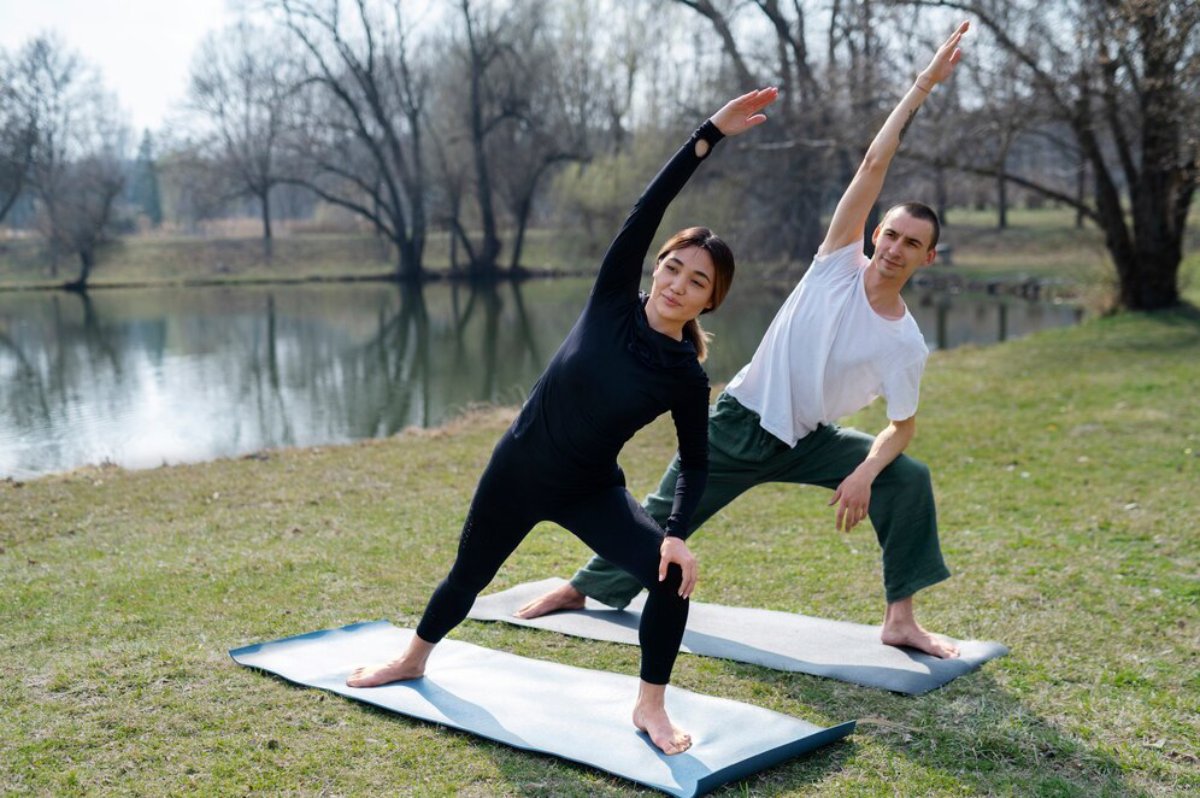The Yoga Blogs

Incorporating Yoga Principles into Daily Life
Imagine waking up feeling centered. Picture moving through your day with steadiness. When challenges arise, respond with calm clarity instead of panic. This isn’t just a dream for monks — it’s the promise of integrating yoga principles into daily life.
Yoga goes beyond what happens on a mat. It’s a way of being — a practical philosophy. Weaving it into your routine can transform your world. The good news? You don’t need hours of practice or costly retreats. Just bring the essence of yoga — mindfulness, balance, compassion — into everyday moments.
This guide explains how yoga can help you:
- Gain mental clarity
- Find emotional balance
- Create a more meaningful daily life
You’ll find practical steps, relatable examples, and gentle encouragement to start your journey, no matter where you are.
What Are Yoga Principles?
Beyond the Poses
When people think of yoga, they often picture flows or tricky poses. But traditionally, yoga includes a broader system that features:
- Ethical guidelines (Yamas and Niyamas)
- Breath control (Pranayama)
- Sense withdrawal (Pratyahara)
- Concentration (Dharana)
- Meditation (Dhyana)
- Joyful absorption (Samadhi)
These key ideas from Patanjali’s Yoga Sutras guide you on your mat and in life.
At its core, yoga asks: How can I live with more awareness, compassion, and connection?
Why Integrate Yoga Principles into Daily Life?
The Modern Mind Needs It
In today’s world of distractions and emotional overwhelm, yoga’s wisdom offers:
- Grounding in a fast-paced environment
- Mental clarity amid information overload
- Emotional resilience through life’s ups and downs
- Deeper connections with yourself and others
Research in the Journal of Behavioural Medicine shows that yoga-based mindfulness practices can lower stress. They also boost cognitive flexibility and improve emotional well-being.
Key Yoga Principles to Embrace Daily
Let’s explore yoga philosophies and habits that can shape your mental clarity and daily well-being.

1. Ahimsa (Non-Violence) — Start with Kindness
Ahimsa invites you to practice non-violence in thought, word, and action — toward yourself and others. Daily application:
- Speak to yourself with encouragement, not criticism.
- Approach disagreements with patience, not hostility.
- Choose gentler actions for your body, mind, and environment. Simple practice: Notice your inner dialogue. Would you say those words to a friend? If not, soften them for yourself.
2. Satya (Truthfulness) — Honor Your Authentic Self
Satya is about living in truth — being honest in your communication, actions, and choices. Daily application:
- Say “no” when you mean it, without guilt.
- Align daily choices (meals, conversations, rest) with your deeper needs.
- Be honest with yourself about emotions without judgment. Mental clarity habit: Pause before responding. Ask: Is this true? Is it necessary? Is it kind?
3. Santosha (Contentment) — Practice Gratitude
Santosha teaches us to find contentment with what is, rather than chasing endless “when I have…” illusions. Daily application:
- Start or end your day by listing three things you’re grateful for.
- Celebrate small wins instead of fixating on future goals.
- See challenges as chances for growth, not barriers to happiness. Perspective shift: Contentment isn’t complacency. It’s the ground where meaningful change takes root.
4. Tapas (Discipline) — Stay Consistent, Compassionately
Tapas encourages dedicated practice — not rigid striving, but purposeful effort. Daily application:
- Show up for your well-being even on “off” days (five minutes counts).
- Stick to routines that nourish you — sleep, movement, mindful eating.
- Embrace small discomforts (e.g., early rising, tough conversations) as part of growth. Encouragement: Consistency builds self-trust. You show yourself that you are worth the effort.
5. Svadhyaya (Self-Study) — Reflect and Refine
Svadhyaya means studying your inner world — your patterns, beliefs, dreams, and habits. Daily application:
- Keep a journal to reflect on moods, triggers, gratitude, and goals.
- Observe your emotional reactions without judgment.
- Explore inspiring texts or teachings (yogic or otherwise). Real-life example: After an argument, instead of blaming, ask: What fear or expectation was I attached to? Growth begins in curiosity.
6. Ishvarapranidhana (Surrender) — Trust the Flow
Finally, Ishvarapranidhana invites you to surrender — trusting life’s bigger picture without needing to control everything. Daily application:
- Let go of the need for immediate results.
- Release small irritations: traffic, queues, delays.
- Trust that not getting what you want now might be redirection, not rejection. Reflection: Control feels safe but often creates tension. Trust creates space for peace.
Integrating Yoga Principles into Your Daily Routine

Morning Routine
- Wake up with gratitude (Santosha).
- Do a short breath practice or stretch (Tapas).
- Set an intention based on one principle (e.g., “Today, I practice Ahimsa toward myself.”).
During Work
- Speak truthfully but kindly in emails and meetings (Satya).
- Notice physical tension — pause and reset (Ahimsa).
- Celebrate small achievements instead of chasing the next task (Santosha).
Evening Wind-Down
- Journal or reflect on emotional patterns noticed (Svadhyaya).
- Let go of unfinished tasks and mentally release the day (Ishvarapranidhana).
- End with a simple ritual of thanks — lighting a candle or sipping tea mindfully.
Real-World Story: Living the Principles Beyond the Mat
Sarah, a busy architect in her late thirties, felt burnt out despite regular yoga classes. Her practice was strong, but daily life was filled with stress and self-criticism.
When her teacher suggested bringing yoga off the mat, especially Ahimsa and Santosha, Sarah began to shift. She caught herself during moments of self-criticism and replaced it with kindness. She celebrated finishing projects instead of fixating on imperfections.
Six months later, she described herself as “not just doing yoga — but being yoga.” The peace she once chased in retreats began blossoming quietly, daily, wherever she went.
Tips for Staying Consistent Without Overwhelm
- Start small: Focus on one principle per week.
- Keep reminders: Use post-it notes, lock screen mantras, or journal prompts.
- Pair habits: Attach principles to existing routines (e.g., gratitude list after brushing teeth).
- Reflect, don’t perfect: Missing a day isn’t failure — it’s feedback. What needs adjusting?
Common Myths About Living Yoga Daily
Myth 1: You need to be “zen” all the time. Truth: It’s about awareness, not perfection. Myth 2: You must radically overhaul your life. Truth: Small shifts create big ripples over time. Myth 3: It’s only for flexible, spiritual types. Truth: Yoga is for everyone with a mind and a heart.
Let Yoga Live Through You
Incorporating yoga principles into daily life isn’t about adding more to your to-do list. It’s about transforming how you do what you already do. It’s about meeting life — its messy mornings, deadlines, laughter, and loss — with a steadier breath and a softer heart.
Living with compassion (Ahimsa), truth (Satya), contentment (Santosha), discipline (Tapas), reflection (Svadhyaya), and surrender (Ishvarapranidhana) means you show mental clarity. It’s not only about reaching that state.
So, where will you begin? Pick one principle today. Let it colour your next choice, your next conversation, your next breath. Which yoga principle resonates with you most right now? Share your thoughts below. Inspire others with your journey. Also, subscribe for more practical ways to blend ancient wisdom with modern living.
Because clarity, peace, and connection aren’t found on some distant retreat — they are cultivated in this moment. In this breath. In this life.









